Battery MITSUBISHI 380 2005 Repair Manual
[x] Cancel search | Manufacturer: MITSUBISHI, Model Year: 2005, Model line: 380, Model: MITSUBISHI 380 2005Pages: 1500, PDF Size: 47.87 MB
Page 406 of 1500
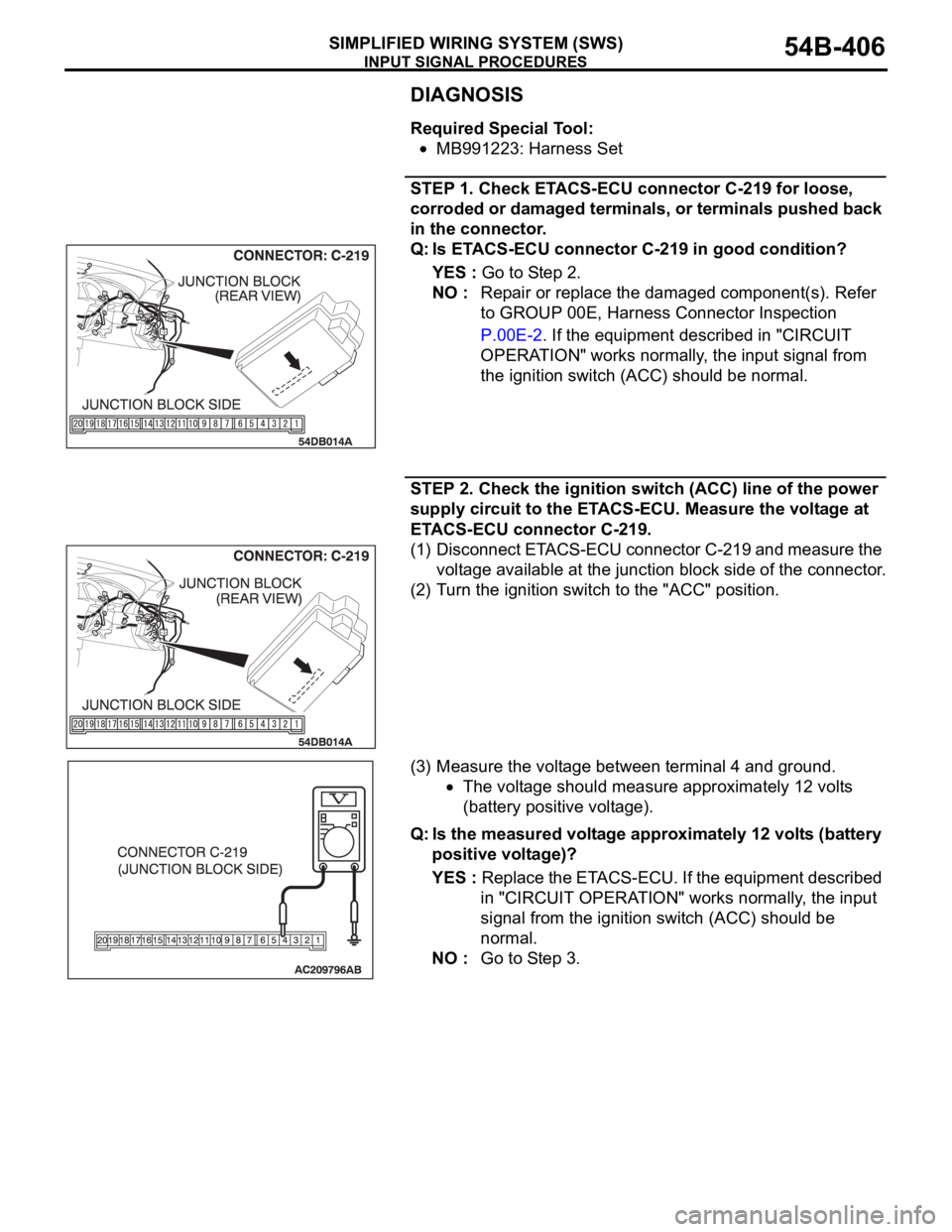
INPUT SIGNAL PROCEDURES
SIMPLIFIED WIRING SYSTEM (SWS)54B-406
DIAGNOSIS
Required Special Tool:
MB991223: Harness Set
STEP 1. Check ETACS-ECU connector C-219 for loose,
corroded or damaged terminals, or terminals pushed back
in the connector.
Q: Is ETACS-ECU connector C-219 in good condition?
YES : Go to Step 2.
NO : Repair or replace the damaged component(s). Refer
to GROUP 00E, Harness Connector Inspection
P.00E-2. If the equipment described in "CIRCUIT
OPERATION" works normally, the input signal from
the ignition switch (ACC) should be normal.
STEP 2. Check the ignition switch (ACC) line of the power
supply circuit to the ETACS-ECU. Measure the voltage at
ETACS-ECU connector C-219.
(1) Disconnect ETACS-ECU connector C-219 and measure the
voltage available at the junction block side of the connector.
(2) Turn the ignition switch to the "ACC" position.
(3) Measure the voltage between terminal 4 and ground.
The voltage should measure approximately 12 volts
(battery positive voltage).
Q: Is the measured voltage approximately 12 volts (battery
positive voltage)?
YES : Replace the ETACS-ECU. If the equipment described
in "CIRCUIT OPERATION" works normally, the input
signal from the ignition switch (ACC) should be
normal.
NO : Go to Step 3.
Page 408 of 1500

INPUT SIGNAL PROCEDURES
SIMPLIFIED WIRING SYSTEM (SWS)54B-408
INSPECTION PROCEDURE M-2: ETACS-ECU does not receive any signal from the ignition switch
(IG1).
.
CIRCUIT OPERATION
The ETACS-ECU operates the following equipment
or functions according to signal from the ignition
switch (IG1):
Light reminder tone alarm function
Seat belt tone alarm function
Door ajar warning buzzer
Turn-signal lamp buzzer
Multi center display operation tone
Power window timer function
Sunroof timer function
Headlamp automatic shutdown function
Turn-signal lamp
Dome lamp dimming function
Ignition key hole illumination lamp
If the power supply circuit from the battery to the
ETACS-ECU is open, this circuit is used as
backup circuit.
If the signal is not normal, the equipment or functions
described in "CIRCUIT OPERATION" do not work
normally.
The ETACS-ECU receives information on the ignition
switch condition (IG1) from the combination meter
via CAN communication. If the ignition switch (IG1)
input signal is incorrect, refer to the Diagnostic Trou-
ble Code Chart P.54B-25.
.
TROUBLESHOOTING HINTS
Refer to circuit diagrams GROUP-90
Refer to configuration diagrams GROUP-80
The wiring harness or connectors may have
loose, corroded, or damaged terminals, or termi-
nals pushed back in the connector
The ETACS-ECU may be defective
DIAGNOSIS
Required Special Tool:
MB991223: Harness Set
STEP 1. Check ETACS-ECU connector C-219 for loose,
corroded or damaged terminals, or terminals pushed back
in the connector.
Q: Is ETACS-ECU connector C-219 in good condition?
YES : Go to Step 2.
NO : Repair or replace the damaged component(s). Refer
to GROUP 00E, Harness Connector Inspection
P.00E-2. If the functions described in "CIRCUIT
OPERATION" work normally, the input signal from the
ignition switch (IG1) should be normal.
Page 409 of 1500

INPUT SIGNAL PROCEDURES
SIMPLIFIED WIRING SYSTEM (SWS)54B-409
STEP 2. Check the ignition switch (IG1) line of the power
supply circuit to the ETACS-ECU. Measure the voltage at
ETACS-ECU connector C-219.
(1) Disconnect ETACS-ECU connector C-219 and measure the
voltage available at the junction block side of the connector.
(2) Turn the ignition switch to the "ON" position.
(3) Measure the voltage between terminal 8 and ground.
The voltage should measure approximately 12 volts
(battery positive voltage).
Q: Is the measured voltage approximately 12 volts (battery
positive voltage)?
YES : Replace the ETACS-ECU. If the functions described
in "CIRCUIT OPERATION" work normally, the input
signal from the ignition switch (IG1) should be normal.
NO : Go to Step 3.
STEP 3. Check the wiring harness between ETACS-ECU
connector C-219 (terminal 8) and the ignition switch (IG1).
Page 472 of 1500

INPUT SIGNAL PROCEDURES
SIMPLIFIED WIRING SYSTEM (SWS)54B-472
INSPECTION PROCEDURE N-8: Transmitter (integrated into key): ETACS-ECU does not receive any
signal from the lock, unlock, trunk or panic switch.
Whenever the ECU is replaced, ensure that the input signal
circuit is normal.
.
COMMENTS ON TROUBLE SYMPTOM
Refer to circuit diagrams GROUP-90
Refer to configuration diagrams GROUP-80
Input signal from the keyless entry transmitter is used to oper-
ate the keyless entry system. If the signal is abnormal, the key-
less entry system will not work normally.
.
POSSIBLE CAUSES
Malfunction of the ETACS-ECU
Malfunction of the keyless entry transmitter
Defective battery of the keyless entry transmitter
1. Lock switch
2. Unlock switch
3. Trunk switch
4. Panic switch
5. Indicator lamp
Page 473 of 1500

INPUT SIGNAL PROCEDURES
SIMPLIFIED WIRING SYSTEM (SWS)54B-473
DIAGNOSTIC PROCEDURE
Step 1. Pulse check
Check whether the ETACS-ECU receives signal from a trans-
mitter or not. For this check, you should use the 4-button-type
transmitter (integrated with a key), which has already been reg-
istered.
NOTE: For how to register the keyless entry transmitter
encrypted code, refer to GROUP 42
On-vehicle Service
P.42-73.
OK: The MUT-III sounds or the voltmeter needle fluctu-
ates.
Q: Is the check result normal?
YES : Go to Step 2.
NO : Go to Step 4.
Step 2. Check the transmitter battery.
Refer to GROUP 42
Keyless entry system P.42-70.
Q: Is the check result normal?
YES : Go to Step 3.
NO : Replace the keyless entry key integrated transmitter
battery.
Step 3. Register the encrypted code, and then retest the
system.
(1) Register the keyless entry transmitter again.
(2) Check that each signal is received from the keyless entry
transmitter.
Q: Is the check result normal?
YES : The trouble can be an intermittent malfunction (Refer
to GROUP 00
How to Cope with Intermittent
Malfunction P.00-14).
NO : Replace the keyless entry transmitter.
Step 4. Retest the system.
Check that each signal is received from the keyless entry key
integrated transmitter.
Q: Is the check result normal?
YES : The trouble can be an intermittent malfunction (Refer
to GROUP 00
How to Cope with Intermittent
Malfunction P.00-14).
NO : Replace the ETACS-ECU. System switch Check condition
Keyless entry transmitter
"LOCK/UNLOCK" switchWhen the switch is
turned from off to on
Keyless entry transmitter
"Panic" switchWhen the switch is
turned from off to on
Keyless entry transmitter
"Trunk" switchWhen the switch is
turned from off to on
Page 475 of 1500
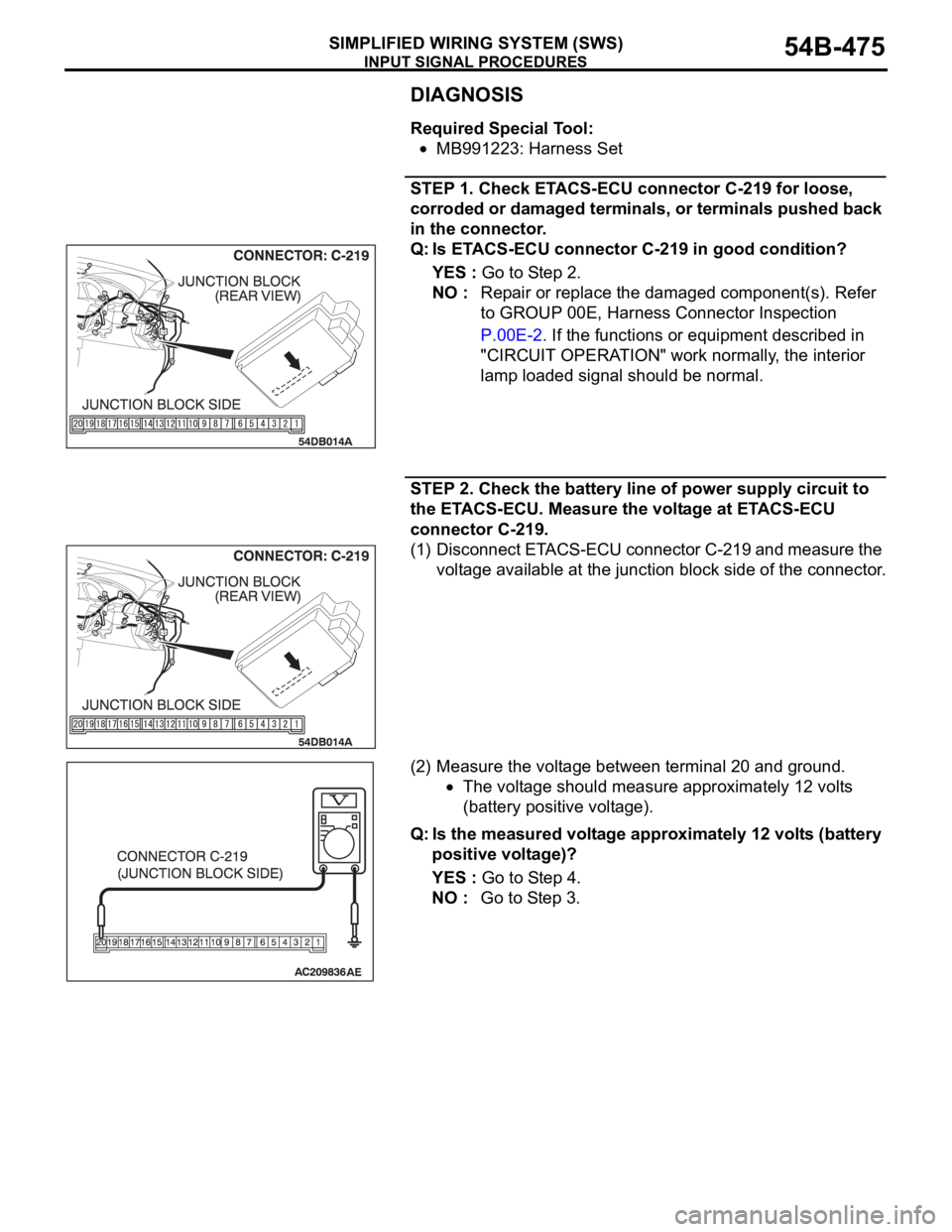
INPUT SIGNAL PROCEDURES
SIMPLIFIED WIRING SYSTEM (SWS)54B-475
DIAGNOSIS
Required Special Tool:
MB991223: Harness Set
STEP 1. Check ETACS-ECU connector C-219 for loose,
corroded or damaged terminals, or terminals pushed back
in the connector.
Q: Is ETACS-ECU connector C-219 in good condition?
YES : Go to Step 2.
NO : Repair or replace the damaged component(s). Refer
to GROUP 00E, Harness Connector Inspection
P.00E-2. If the functions or equipment described in
"CIRCUIT OPERATION" work normally, the interior
lamp loaded signal should be normal.
STEP 2. Check the battery line of power supply circuit to
the ETACS-ECU. Measure the voltage at ETACS-ECU
connector C-219.
(1) Disconnect ETACS-ECU connector C-219 and measure the
voltage available at the junction block side of the connector.
(2) Measure the voltage between terminal 20 and ground.
The voltage should measure approximately 12 volts
(battery positive voltage).
Q: Is the measured voltage approximately 12 volts (battery
positive voltage)?
YES : Go to Step 4.
NO : Go to Step 3.
Page 476 of 1500
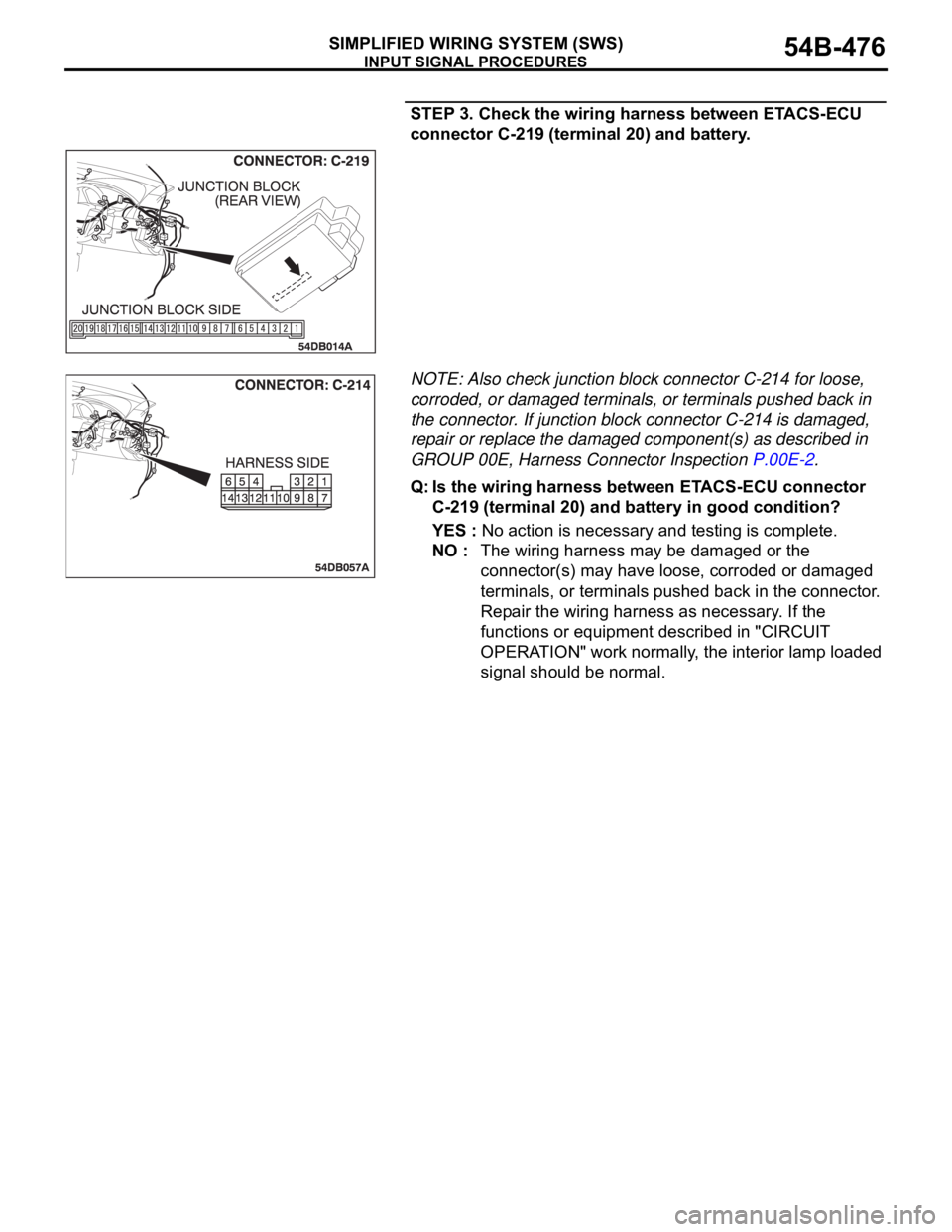
INPUT SIGNAL PROCEDURES
SIMPLIFIED WIRING SYSTEM (SWS)54B-476
STEP 3. Check the wiring harness between ETACS-ECU
connector C-219 (terminal 20) and battery.
NOTE: Also check junction block connector C-214 for loose,
corroded, or damaged terminals, or terminals pushed back in
the connector. If junction block connector C-214 is damaged,
repair or replace the damaged component(s) as described in
GROUP 00E, Harness Connector Inspection P.00E-2.
Q: Is the wiring harness between ETACS-ECU connector
C-219 (terminal 20) and battery in good condition?
YES : No action is necessary and testing is complete.
NO : The wiring harness may be damaged or the
connector(s) may have loose, corroded or damaged
terminals, or terminals pushed back in the connector.
Repair the wiring harness as necessary. If the
functions or equipment described in "CIRCUIT
OPERATION" work normally, the interior lamp loaded
signal should be normal.
Page 477 of 1500
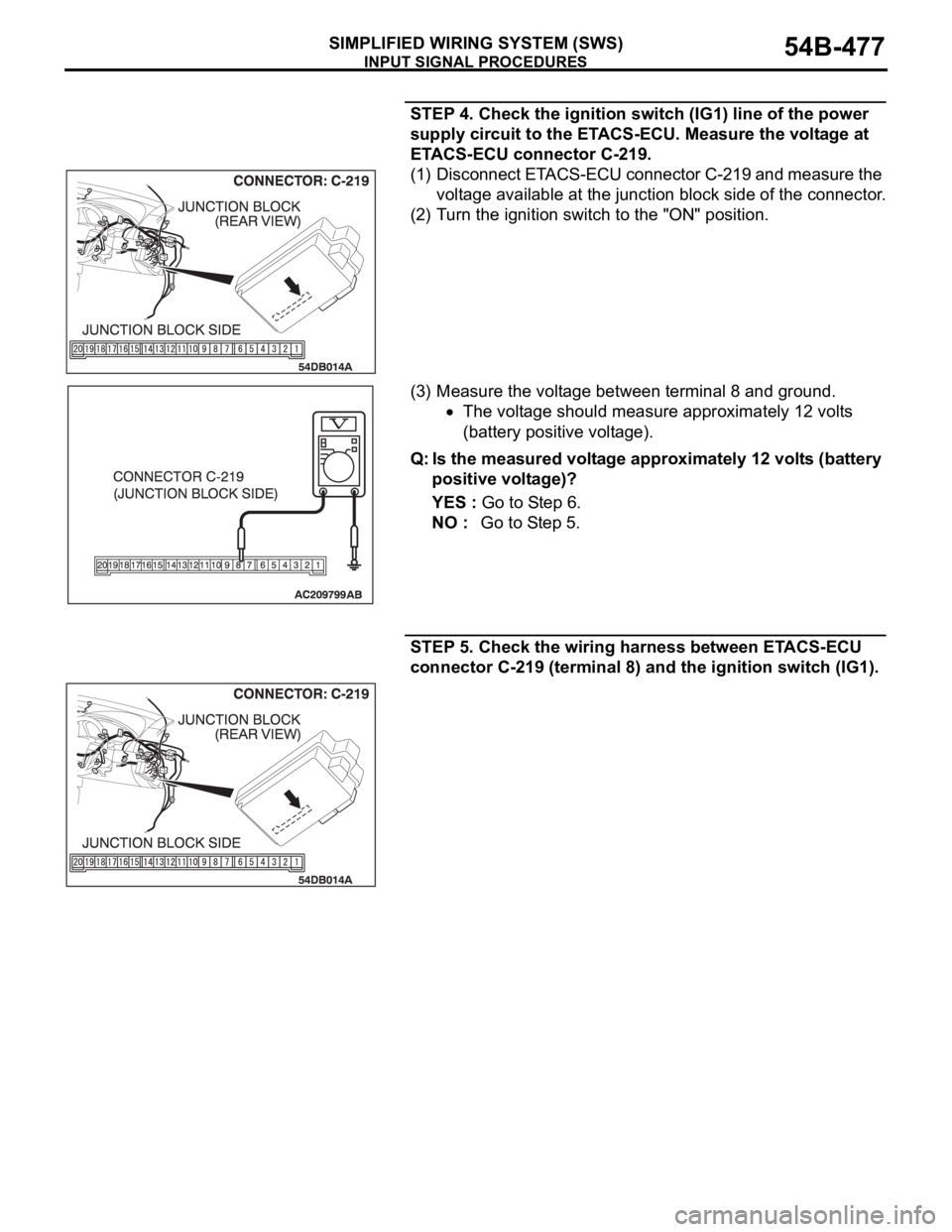
INPUT SIGNAL PROCEDURES
SIMPLIFIED WIRING SYSTEM (SWS)54B-477
STEP 4. Check the ignition switch (IG1) line of the power
supply circuit to the ETACS-ECU. Measure the voltage at
ETACS-ECU connector C-219.
(1) Disconnect ETACS-ECU connector C-219 and measure the
voltage available at the junction block side of the connector.
(2) Turn the ignition switch to the "ON" position.
(3) Measure the voltage between terminal 8 and ground.
The voltage should measure approximately 12 volts
(battery positive voltage).
Q: Is the measured voltage approximately 12 volts (battery
positive voltage)?
YES : Go to Step 6.
NO : Go to Step 5.
STEP 5. Check the wiring harness between ETACS-ECU
connector C-219 (terminal 8) and the ignition switch (IG1).
Page 478 of 1500
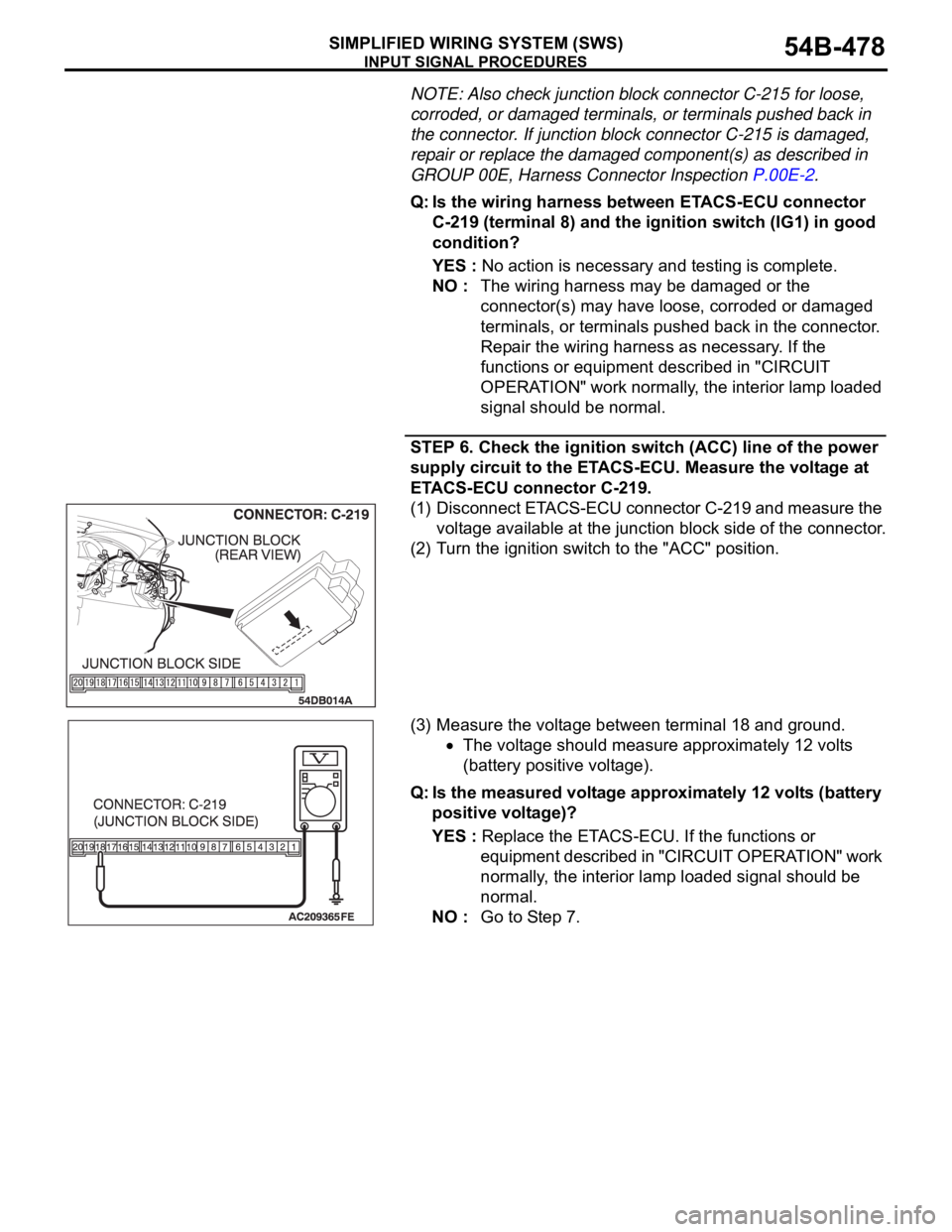
INPUT SIGNAL PROCEDURES
SIMPLIFIED WIRING SYSTEM (SWS)54B-478
NOTE: Also check junction block connector C-215 for loose,
corroded, or damaged terminals, or terminals pushed back in
the connector. If junction block connector C-215 is damaged,
repair or replace the damaged component(s) as described in
GROUP 00E, Harness Connector Inspection P.00E-2.
Q: Is the wiring harness between ETACS-ECU connector
C-219 (terminal 8) and the ignition switch (IG1) in good
condition?
YES : No action is necessary and testing is complete.
NO : The wiring harness may be damaged or the
connector(s) may have loose, corroded or damaged
terminals, or terminals pushed back in the connector.
Repair the wiring harness as necessary. If the
functions or equipment described in "CIRCUIT
OPERATION" work normally, the interior lamp loaded
signal should be normal.
STEP 6. Check the ignition switch (ACC) line of the power
supply circuit to the ETACS-ECU. Measure the voltage at
ETACS-ECU connector C-219.
(1) Disconnect ETACS-ECU connector C-219 and measure the
voltage available at the junction block side of the connector.
(2) Turn the ignition switch to the "ACC" position.
(3) Measure the voltage between terminal 18 and ground.
The voltage should measure approximately 12 volts
(battery positive voltage).
Q: Is the measured voltage approximately 12 volts (battery
positive voltage)?
YES : Replace the ETACS-ECU. If the functions or
equipment described in "CIRCUIT OPERATION" work
normally, the interior lamp loaded signal should be
normal.
NO : Go to Step 7.
Page 480 of 1500
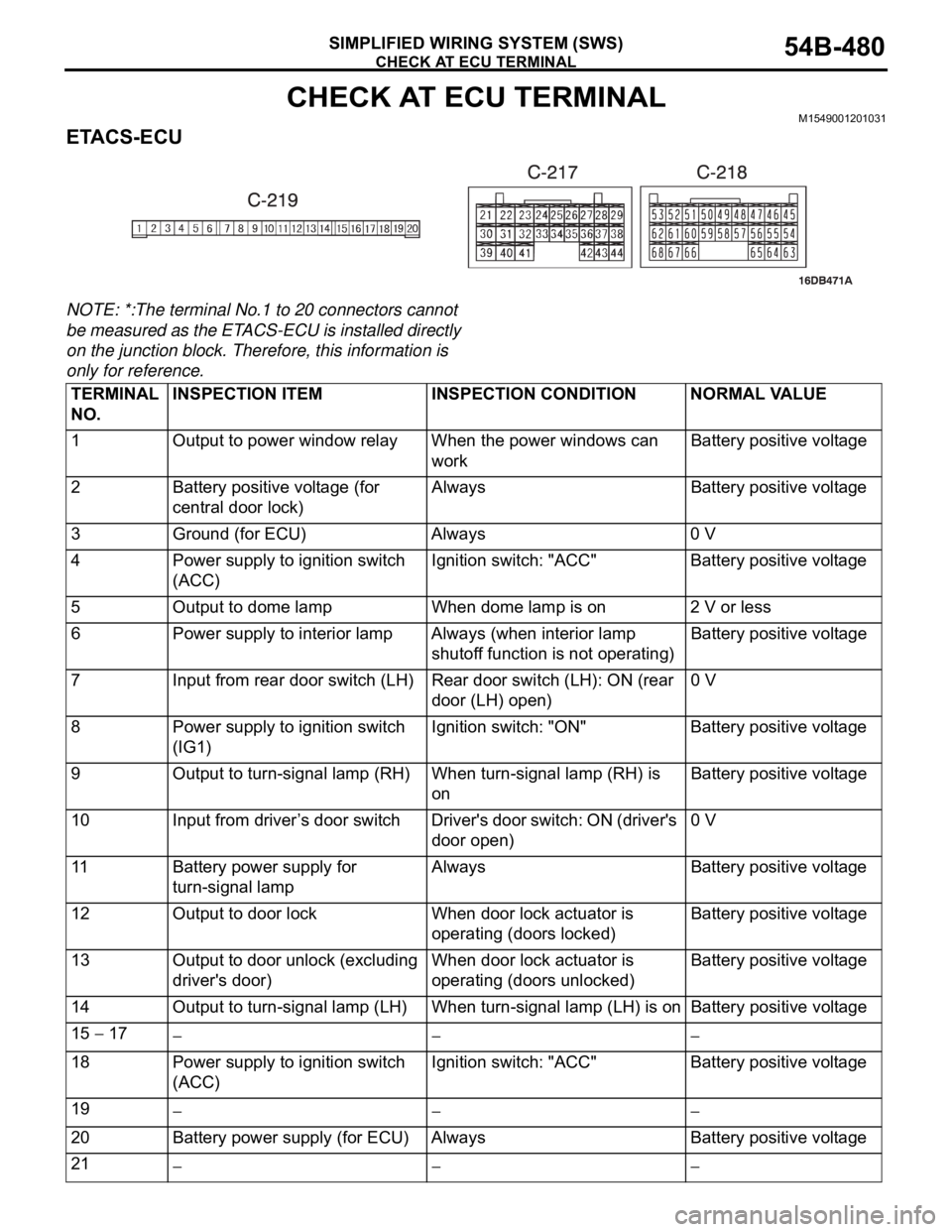
CHECK AT ECU TERMINAL
SIMPLIFIED WIRING SYSTEM (SWS)54B-480
CHECK AT ECU TERMINALM1549001201031
ETACS-ECU
NOTE: *:The terminal No.1 to 20 connectors cannot
be measured as the ETACS-ECU is installed directly
on the junction block. Therefore, this information is
only for reference.
TERMINAL
NO.INSPECTION ITEM INSPECTION CONDITION NORMAL VALUE
1 Output to power window relay When the power windows can
workBattery positive voltage
2 Battery positive voltage (for
central door lock)Always Battery positive voltage
3 Ground (for ECU) Always 0 V
4 Power supply to ignition switch
(ACC)Ignition switch: "ACC" Battery positive voltage
5 Output to dome lamp When dome lamp is on 2 V or less
6 Power supply to interior lamp Always (when interior lamp
shutoff function is not operating)Battery positive voltage
7 Input from rear door switch (LH) Rear door switch (LH): ON (rear
door (LH) open)0 V
8 Power supply to ignition switch
(IG1)Ignition switch: "ON" Battery positive voltage
9 Output to turn-signal lamp (RH) When turn-signal lamp (RH) is
onBattery positive voltage
10 Input from driver’s door switch Driver's door switch: ON (driver's
door open)0 V
11 Battery power supply for
turn-signal lampAlways Battery positive voltage
12 Output to door lock When door lock actuator is
operating (doors locked)Battery positive voltage
13 Output to door unlock (excluding
driver's door)When door lock actuator is
operating (doors unlocked) Battery positive voltage
14 Output to turn-signal lamp (LH) When turn-signal lamp (LH) is on Battery positive voltage
15
17
18 Power supply to ignition switch
(ACC)Ignition switch: "ACC" Battery positive voltage
19
20 Battery power supply (for ECU) Always Battery positive voltage
21